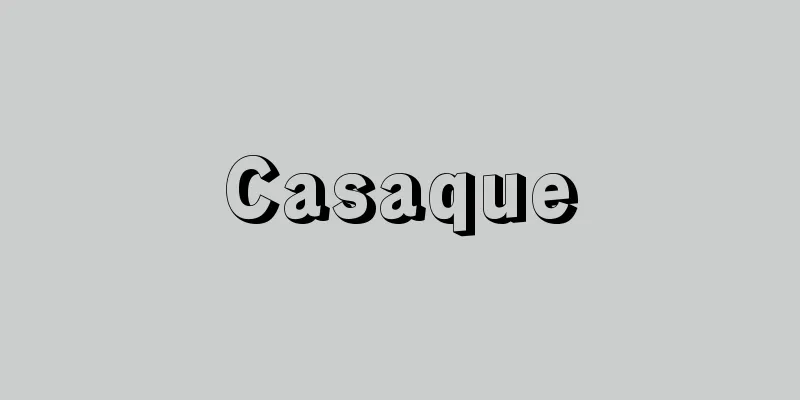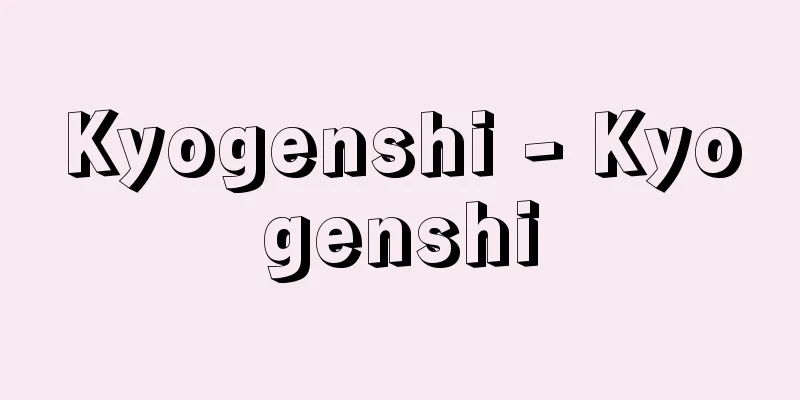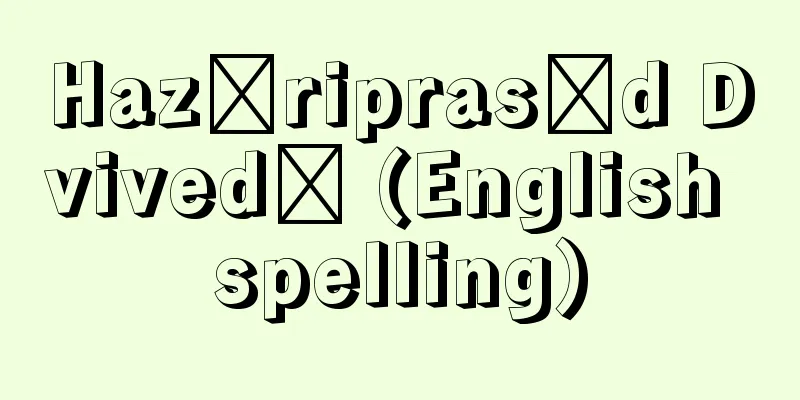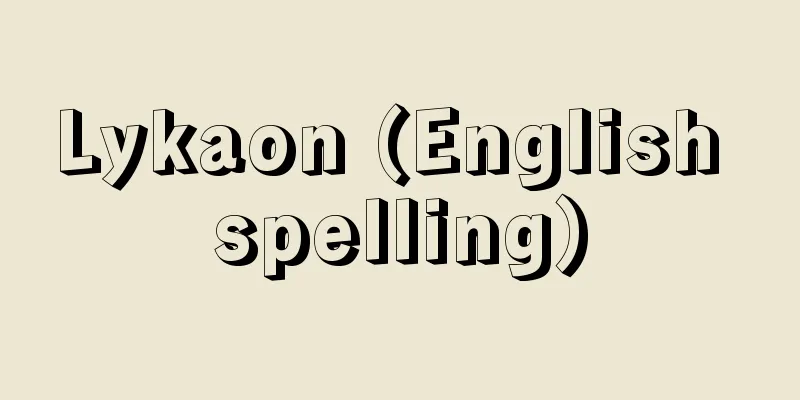Appraisal

|
Generally speaking, it refers to determining the authenticity and quality of an item through investigation and deciding on a price. The person who does this is called an appraiser. Professionally, there is appraisal under procedural law, specifically parentage appraisal, handwriting appraisal, and psychiatric appraisal, as well as scientific appraisal in criminal investigations, appraisal of artworks and product appraisal, and scientific appraisal methods for these. This article explains appraisal under procedural law, appraisal of artworks, and scientific appraisal methods. For information on "parentage appraisal," "handwriting appraisal," "psychiatric appraisal," "product appraisal," and "scientific investigations," please refer to the respective entries. [Ichiro Uchida] Expert opinion in litigation lawIn the Code of Criminal Procedure, an expert witness is a person with special knowledge and experience who reports on a rule of fact or a judgment reached by applying that rule to specific facts. The entire process of examining evidence to produce this report is sometimes called an expert witness (Criminal Procedure Code, Part 1, Chapter 12), and the expert witness' activities themselves are sometimes called an expert witness (Criminal Procedure Code, Article 170, etc.). Since an expert witness provides a judgment based on special knowledge and experience, he or she is distinguished from a witness who testifies about the facts of his or her own experience. However, when questioning a person about the facts of their past experience based on special knowledge and experience, they are treated as a witness, not an expert witness (Criminal Procedure Code, Article 174). They are what is known as expert witnesses. Expert examinations are ordered by the court (Article 165 of the same law), but investigative agencies may also commission an expert examination during the investigation stage (Article 223, Paragraph 1 of the same law). In this case, the person commissioned to perform the expert examination is called the expert examination commissioner. The subject of the expert examination is wide-ranging, but the most common are forensic examinations on the cause of death and psychiatric examinations on the mental state of the defendant. Experts are obligated to appear, to take an oath, and to perform the expert examination and report the results of the examination (Articles 166 and 171 of the same law). However, since experts are replaceable, experts who do not respond to a summons cannot be subpoenaed (Article 171 of the same law). Experts may, when necessary for the expert examination, enter residences, etc., examine bodies, dissect corpses, excavate graves, or destroy objects with the permission of the court (Article 168 of the same law). This is called an expert examination disposition, and is carried out with a court-issued expert examination disposition permit. When blood or other samples are forcibly taken during the investigation stage, they are carried out using a warrant for medical examination in addition to a warrant for expert testimony, which allows for direct compulsory measures. However, as forcible collection of urine samples, precedent has determined that it may be carried out with a warrant for search and seizure that includes conditions such as a doctor's presence, so in practice, this is carried out using a warrant for compulsory urine collection. When it is necessary for an expert test of the defendant's mind or body, the court may detain the defendant in a hospital or other appropriate location for a set period of time (Article 167 of the same law). This is called detention for expert testimony. The results of the appraisal can be reported orally (Article 304 of the same law), but since the contents of the appraisal are often specialized and complex, it is common to submit an appraisal report that contains the process and results of the appraisal. As an appraisal report is written, it is subject to the hearsay rule (Article 320, Paragraph 1 of the same law), but it is treated differently from a general statement record, and if the appraiser is questioned at the trial date and states that the report is genuine, it is admissible as evidence (Article 321, Paragraph 4 of the same law). Regarding the results of the appraisal, precedents have stated that, for example, even in the case of a psychiatric appraisal, the result of the appraisal is not binding because the capacity to be held responsible is a legal judgment, but that the opinion of the appraiser should be fully respected unless there are reasonable circumstances that make the appraisal result unacceptable. Appraisers have the right to claim travel expenses, daily allowances, accommodation expenses, appraisal fees, etc. (Article 173 of the same law). Under the Civil Procedure Act, this refers to the examination of evidence for the purpose of seeking the opinion of a knowledgeable third party (expert) in order to supplement the judge's ability to make judgments (Articles 212 and following of the same Act). [Moriichi Taguchi] Art AppraisalWorks of art are always accompanied by similar items. Distinguishing copies, replicas, forgeries, and copies from genuine works requires the judgement of an expert. This is the professional act of appraisal. Whether or not an art work, which is in principle a one-off or limited production, is an original has a significant impact on its value. For this reason, the vast majority of art works must be appraised, and are actually appraised. However, there are rare cases of complex works that are not easy to appraise, and sometimes appraisers make erroneous judgments due to lack of ability, which creates confusion. Furthermore, opinions can change based on the results of years of research, and there is an inherent element of uncertainty in the appraisal of art works. Although perfect and permanent appraisal is impossible for all artworks, advances in scholarship and research, as well as the development of materials and equipment, have made appraisals more definitive than ever before. While traditional appraisal methods were left to the empirical judgment of specific connoisseurs, the modern method has opened up a way to achieve objective validity, mainly through the effective use of materials and equipment. Today, appraisal has become the skill of a wide range of specialist researchers, and is no longer the job of professional appraisers. Furthermore, the results of appraisals are no longer simply issued in writing or written on a box, which can easily lead to misunderstandings, but are now always accompanied by photographs and documents. Appraisals made after the Second World War must now be re-appraised using new methods. While appraisals are often the work of individual experts, national and public facilities also place great importance on the subject and have recently been expanding their departments for the purpose. Art appraisal involves determining whether an item is genuine or counterfeit, as well as determining its monetary value. In the West, the experts who specialize in this area are called appraisers. [Shinichi Segi] Scientific MethodsMagnified observation with an optical microscope and fluorescence from ultraviolet light are used to observe the unique fluorescence of each material, such as varnish, oil, and pigment, to estimate the materials and repaired areas, and infrared absorption is used to decipher ink inscriptions stained with oily smoke. Infrared television in particular uses a camera equipped with an infrared sensor that is sensitive to a wider near-infrared range than infrared film, making it possible to capture the effects directly on a cathode ray tube, and is used to decipher inscriptions and clarify sketches based on the different absorption effects of different materials. X-ray radiography is used to investigate the structure of paintings, sculptures, and crafts, as well as layers of pigment, brush strokes, and repairs. Hard and soft X-rays are used depending on the material and thickness, and for thicker metal products, techniques such as casting and forging are revealed using radioisotope gamma rays. On the other hand, there are analytical methods that can clarify chemical components and composition. The general rule for investigating the materials of cultural properties is to use non-destructive methods, and X-ray fluorescence analysis and X-ray diffraction analysis are used. The former is an elemental analysis, while the latter is a method for identifying compounds from their crystal structure. Furthermore, when extremely small amounts of samples can be collected, activation analysis, emission spectrometry, and isotope analysis using a mass spectrometer can be used to clarify the characteristics of the trace components, making it possible to estimate the age and place of origin of the material. If a comprehensive assessment using these methods proves that a work is made using materials and techniques that were used at a certain time, it is deemed to be genuine. [Yoshitaka Emoto] [References] | | | | | of authenticity | | | | | | | | | | |Source: Shogakukan Encyclopedia Nipponica About Encyclopedia Nipponica Information | Legend |
|
一般的には、ものの真贋(しんがん)や品質のよしあしを調査のうえで見きわめたり、価格を決めたりすること。またそれを行う人を鑑定人という。専門的には、訴訟法上の鑑定、具体的には親子鑑定、筆跡鑑定、精神鑑定などがあり、また犯罪における科学捜査上の鑑定のほか、美術品の鑑定や商品鑑定、さらにこれらの科学的鑑定法などがある。ここでは、訴訟法上の鑑定と美術品の鑑定およびその科学的鑑定法について解説する。「親子鑑定」「筆跡鑑定」「精神鑑定」「商品鑑定」「科学捜査」については、それぞれの項目を参照のこと。 [内田一郎] 訴訟法における鑑定刑事訴訟法においては、特別の知識経験を有する者により、事実の法則またはその法則を具体的事実に適用して得た判断を報告すること。この報告をなす証拠調べの全体を鑑定ということも(刑事訴訟法1編12章)、鑑定人の活動自体を鑑定ということも(同法170条等)ある。鑑定人は、特別の知識経験に基づく判断を提供するものであるから、自己の体験事実を供述する証人とは区別される。なお、特別の知識経験に基づく者の過去の体験事実について尋問する場合は、鑑定人ではなく証人として扱われることとされている(同法174条)。いわゆる鑑定証人である。 鑑定は、裁判所が命ずるものであるが(同法165条)、捜査段階において捜査機関が鑑定を嘱託することもある(同法223条1項)。この場合に鑑定を嘱託された者は鑑定受託者とよばれる。鑑定事項は多岐にわたるが、人の死亡原因等に関する法医学鑑定や被告人の精神状態に関する精神鑑定等が多い。鑑定人は、出頭の義務、宣誓の義務、鑑定および鑑定結果の報告の義務を負う(同法166条、171条)。ただし、鑑定人には代替性があるので、召喚に応じない鑑定人を勾引(こういん)することはできない(同法171条)。鑑定人は、鑑定について必要があるときは、裁判所の許可を受けて、住居等への立入り、身体の検査、死体の解剖、墳墓の発掘または物の破壊をすることができる(同法168条)。これを鑑定処分といい、裁判所の鑑定処分許可状によって行う。捜査段階で強制的に血液等を採取するときは、鑑定処分許可状のほか直接的な強制処分を可能とする身体検査令状を併用して実施している。ただし、尿の強制採取については、判例は、医師による等の条件を付した捜索差押許可状により実施しうるとしたので、実務はこのいわゆる強制採尿令状によって行っている。被告人の心神または身体に関する鑑定のために必要であるときは、裁判所は、期間を定め、病院その他の相当な場所に被告人を留置することができる(同法167条)。これを鑑定留置という。 鑑定の結果は、口頭で報告することもできるが(同法304条)、鑑定内容が専門的で複雑である場合も多いことから、鑑定の経過および結果を書面にした鑑定書を提出することが一般的である。鑑定書は、書面であるから伝聞法則(同法320条1項)の適用を受けるが、一般の供述調書とは異なった取扱いがなされており、鑑定人が公判期日において尋問を受け、その真正に作成されたものであることを供述したときは、証拠として許容されることとなっている(同法321条4項)。鑑定の結果について、判例は、たとえば精神鑑定であっても責任能力は法律判断であるから鑑定の結果には拘束されないとしているが、鑑定結果を採用しえない合理的事情が認められるのでない限り、その意見を十分に尊重すべきであるとしている。鑑定人は、旅費、日当および宿泊費のほか、鑑定料などを請求する権利を有する(同法173条)。 なお、民事訴訟法上は、裁判官の判断能力を補充するために学識経験のある第三者(鑑定人)の意見を求めることを目的とする証拠調べをいう(同法212条以下)。 [田口守一] 美術品の鑑定美術品には類同品が付き物である。模写、レプリカ(模造品)、贋作(がんさく)、複製物といったものを真作から区別するためには、専門家の判断が必要となる。それが鑑定という専門的行為である。原則として一品制作もしくは限定制作である美術品がオリジナルであるかどうかは、価値に関して多大の影響を及ぼす。そこで、大多数の美術品は鑑定されなければならず、現に鑑定されている。しかし、鑑定が容易でない複雑な作品がまれにあり、また、鑑定者の能力の不足による誤断もときにはあって、混乱が生ずる。さらに、長年の研究成果によって見解が変化する場合もあり、美術品の鑑定には不安定な要素が内在している。 完全で恒久的な鑑定はすべての美術品にはありえないとしても、学問と研究の進歩、そして資料の整備と機器の発達に伴い、以前とは比較にならぬほど、鑑定は確定性を増している。特定の目利きの経験的判断にゆだねられていた従来の鑑定法に対して、現代では、主として資料と機器を有効に利用することで客観的な妥当性へ至る道が開けてきた。 今日、鑑定は広く専門研究者の具有する能力となり、職業的鑑定家の仕事ではなくなっている。そして鑑定の結果も、単に文書を発行するとか、箱に書記するとかという、とかく誤解を生じやすい仕方ではなしに、写真や文献をかならず添付する方法に変化している。第二次世界大戦後までに受けた鑑定は、いま改めて新しい方法による再鑑定が必要である。 鑑定は多く個々の専門家の仕事として行われているが、国・公立の施設でもそれを重視し、最近ではそのための部門を充実させている。 美術鑑定は、真贋の区別とともに、その金銭的評価という部分を含む。その面をとくに行う専門家を欧米ではアプレイザーappraiserとよんでいる。 [瀬木慎一] 科学的鑑定法光学顕微鏡等による拡大観察、紫外線による蛍光作用により、ニス、油、顔料(がんりょう)等、それぞれの材料特有の蛍光を観察し、材料や補修部分を推定し、赤外線の吸収作用を応用して、油煙等に汚れた墨書を解読する。とくに赤外テレビジョンは、赤外線フィルムより広い近赤外領域に感度をもつ赤外線センサーを備えたカメラを用い、ブラウン管上に直接その影響をとらえることが可能で、材質によって異なる吸収作用から銘文の判読、下絵の解明等に利用される。X線の透過写真は、絵画、彫刻、工芸品等の構造をはじめ、顔料の塗り重ね、筆のタッチ、補修等を探るのに用いられる。材質と厚さによって硬・軟X線を使い分け、さらに厚みのある金属製品には、ラジオ・アイソトープのγ(ガンマ)線を用いて鋳造、鍛造等の技法が明らかにされる。 一方、化学成分や組成を明らかにする分析手段がある。文化財には非破壊的方法による材質調査が大原則で、蛍光X線分析、X線回折分析が用いられる。前者は元素分析で、後者は結晶構造から化合物を同定する方法である。また極微量の試料が採取できた場合は、放射化分析、発光分光分析、質量分析計による同位体分析等が行われ、微量成分の特徴が解明されて材料の時代や産地の推定が可能となる。 これらの方法で、ある時代に使われていた材料と製作技法にかなった作品であることが、複数の方法で総合的に判定できれば、それは本物であると判断される。 [江本義理] [参照項目] | | | | | | | | | | | | | | | |出典 小学館 日本大百科全書(ニッポニカ)日本大百科全書(ニッポニカ)について 情報 | 凡例 |
<<: Canti - Kanthi (English spelling)
Recommend
Arnulfus - Arnulfus
…He was a layman who became the Bishop of Metz (n...
Allomon - Allomon
Kairomones are substances that are generally call...
Amarume Oil Field
An oil field located in Shonai Town, Higashitagawa...
Onji (relative) - Onji
...In Kikaijima, Amami, they were called Okura an...
Science - kagaku (English spelling) science
Ancient and Medieval Natural Science Since ancien...
Whistler
1834‐1921 Swiss Germanic legal scholar. Professor ...
Offering - Kumotsu
In the narrow sense, it refers to food and drink ...
haze wax
…A waxy substance obtained mainly from the fruit ...
Anode ray
A flow of positive ions that flows from the anode...
Monomorium pharaonis (English name) Monomoriumpharaonis
…[Masao Kubota]. … *Some of the terminology that ...
Seo Jeong-ju (English spelling) Sŏ Chŏn-gju
1915‐2000 Korean poet. His pen name is Midang. He ...
Akoya
[1] [Name] ① Abbreviation of "akoyadama (Akoy...
Transvaal Coal Fields
A general term for the Waterberg, Springs, Witbank...
Pele
...This figure is almost the same as that of an 8...
Japanese name - Wamei
This refers to the common Japanese name given to ...









